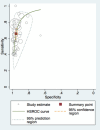The American Society for Microbiology collaboration with the CDC Laboratory Medicine Best Practices initiative for evidence-based laboratory medicine
- PMID: 39320097
- PMCID: PMC11629616
- DOI: 10.1128/cmr.00065-18
The American Society for Microbiology collaboration with the CDC Laboratory Medicine Best Practices initiative for evidence-based laboratory medicine
Abstract
SUMMARYClinical medicine has embraced the use of evidence for patient treatment decisions; however, the evaluation strategy for evidence in laboratory medicine practices has lagged. It was not until the end of the 20th century that the Institute of Medicine (IOM), now the National Academy of Medicine, and the Centers for Disease Control and Prevention, Division of Laboratory Systems (CDC DLS), focused on laboratory tests and how testing processes can be designed to benefit patient care. In collaboration with CDC DLS, the American Society for Microbiology (ASM) used an evidence review method developed by the CDC DLS to develop a program for creating laboratory testing guidelines and practices. The CDC DLS method is called the Laboratory Medicine Best Practices (LMBP) initiative and uses the A-6 cycle method. Adaptations made by ASM are called Evidence-based Laboratory Medicine Practice Guidelines (EBLMPG). This review details how the ASM Systematic Review (SR) Processes were developed and executed collaboratively with CDC's DLS. The review also describes the ASM transition from LMBP to the organization's current EBLMPG, maintaining a commitment to working with agencies in the U.S. Department of Health and Human Services and other partners to ensure that EBLMPG evidence is readily understood and consistently used.
Keywords: evidence-based medicine; meta-analysis; outcomes; systematic review.
Conflict of interest statement
The authors declare no conflict of interest.
Figures







Similar articles
-
The future of Cochrane Neonatal.Early Hum Dev. 2020 Nov;150:105191. doi: 10.1016/j.earlhumdev.2020.105191. Epub 2020 Sep 12. Early Hum Dev. 2020. PMID: 33036834
-
Assessing Clinical Microbiology Practice Guidelines: American Society for Microbiology Ad Hoc Committee on Evidence-Based Laboratory Medicine Practice Guidelines Assessment.J Clin Microbiol. 2017 Nov;55(11):3183-3193. doi: 10.1128/JCM.01124-17. Epub 2017 Aug 23. J Clin Microbiol. 2017. PMID: 28835476 Free PMC article. Review.
-
ASM LabCap's contributions to disease surveillance and the International Health Regulations (2005).BMC Public Health. 2010 Dec 3;10 Suppl 1(Suppl 1):S7. doi: 10.1186/1471-2458-10-S1-S7. BMC Public Health. 2010. PMID: 21143829 Free PMC article.
-
Evaluation of CDC's Hemophilia Surveillance Program - Universal Data Collection (1998-2011) and Community Counts (2011-2019), United States.MMWR Surveill Summ. 2020 Sep 4;69(5):1-18. doi: 10.15585/mmwr.ss6905a1. MMWR Surveill Summ. 2020. PMID: 32881847 Free PMC article.
-
Effectiveness of Preanalytic Practices on Contamination and Diagnostic Accuracy of Urine Cultures: a Laboratory Medicine Best Practices Systematic Review and Meta-analysis.Clin Microbiol Rev. 2016 Jan;29(1):105-47. doi: 10.1128/CMR.00030-15. Clin Microbiol Rev. 2016. PMID: 26598386 Free PMC article.
Cited by
-
American Society for Microbiology evidence-based laboratory medicine practice guidelines to reduce blood culture contamination rates: a systematic review and meta-analysis.Clin Microbiol Rev. 2024 Dec 10;37(4):e0008724. doi: 10.1128/cmr.00087-24. Epub 2024 Nov 4. Clin Microbiol Rev. 2024. PMID: 39495314 Free PMC article.
References
-
- Buehler SS, Madison B, Snyder SR, Derzon JH, Cornish NE, Saubolle MA, Weissfeld AS, Weinstein MP, Liebow EB, Wolk DM. 2016. Effectiveness of practices to increase timeliness of providing targeted therapy for inpatients with bloodstream infections: a laboratory medicine best practices systematic review and meta-analysis. Clin Microbiol Rev 29:59–103. doi:10.1128/CMR.00053-14 - DOI - PMC - PubMed
-
- LaRocco MT, Franek J, Leibach EK, Weissfeld AS, Kraft CS, Sautter RL, Baselski V, Rodahl D, Peterson EJ, Cornish NE. 2016. Effectiveness of preanalytic practices on contamination and diagnostic accuracy of urine cultures: a laboratory medicine best practices systematic review and meta-analysis. Clin Microbiol Rev 29:105–147. doi:10.1128/CMR.00030-15 - DOI - PMC - PubMed
-
- Kraft CS, Parrott JS, Cornish NE, Rubinstein ML, Weissfeld AS, McNult P, Nachamkin I, Humphries RM, Kirn TJ, Dien Bard J, Lutgring JD, Gullett JC, Bittencourt CE, Benson S, Bobenchik AM, Sautter RL, Baselski V, Atlas MC, Marlowe EM, Miller NS, Fischer M, Richter SS, Gilligan P, Snyder JW. 2019. A laboratory medicine best practices systematic review and meta-analysis of nucleic acid amplification tests (NAATs) and algorithms including NAATs for the diagnosis of Clostridioides (Clostridium) difficile in adults. Clin Microbiol Rev 32:e00032-18. doi:10.1128/CMR.00032-18 - DOI - PMC - PubMed
-
- Snyder SR, Favoretto AM, Baetz RA, Derzon JH, Madison BM, Mass D, Shaw CS, Layfield CD, Christenson RH, Liebow EB. 2012. Effectiveness of practices to reduce blood culture contamination: a laboratory medicine best practices systematic review and meta-analysis. Clin Biochem 45:999–1011. doi:10.1016/j.clinbiochem.2012.06.007 - DOI - PMC - PubMed
Publication types
MeSH terms
LinkOut - more resources
Full Text Sources
Medical
Research Materials

